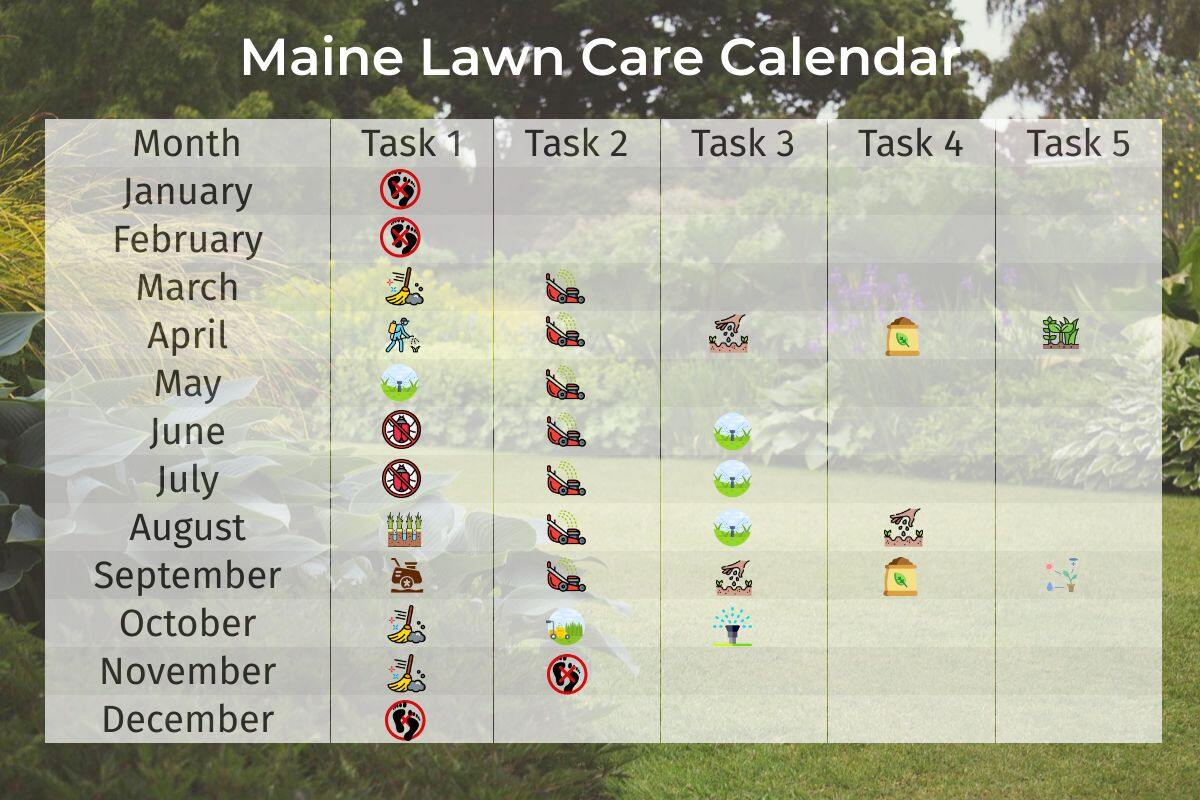
Accustomed to “The Way Life Should Be,” you can also add “The Way Lawn Care Should Be” to your Mainer handbook. We’ve created this month-to-month lawn care guide for Maine homeowners, making phrases like “lawn pest control” or “proper mowing height” less frightening than a Stephen King novel.
Those Sunday lawn care chores? They no longer have to cast a shadow over your weekend plans. Let’s walk through the seasons, from the first blooms of spring to the fall of snowflakes, exploring the nuances of caring for your lawn in Vacationland.
Maine Lawn Care: A Month-to-Month Guide at a Glance
*Hover over or tap each icon to read the task.
Spring Lawn Care in Maine: March to May
As winter finally loosens its icy grip, it’s time to prepare your lawn for spring growth. From gentle raking to performing weed control and addressing any bare patches, this is an active season for any Mainiac green thumb.
Reach Out to Your Rake — March
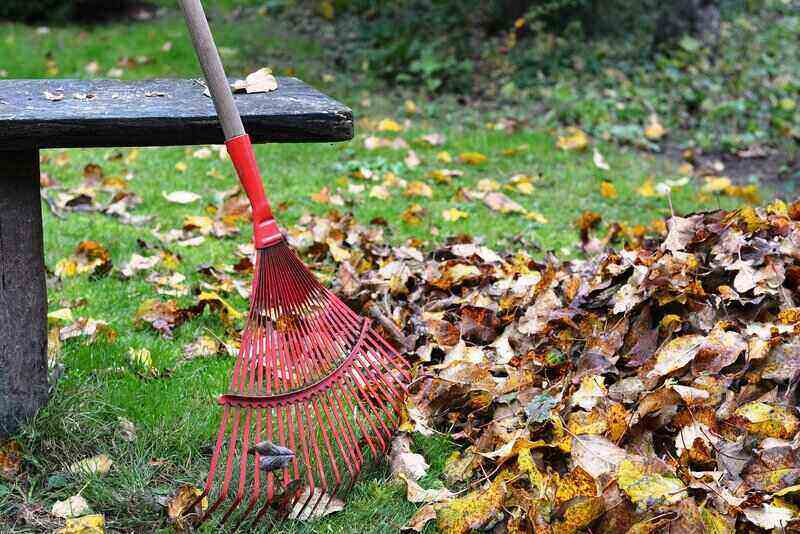
Ditch the winter blues and welcome the spring hues. March is the month when ground temperatures start their ascent, giving you a perfect excuse to brave that crisp Maine air. As soon as your lawn is clear of snow and dry enough, pick up your rake to give it a gentle once-over.
This helps remove any dead growth and winter debris and gives you a headstart in spotting any developing turf disease or pest attacks. Light raking also stimulates fresh grass shoots, aiding quick recovery after winter.
Mow Your Lawn — Late March to Early April
Are you missing the smell of freshly cut grass? It’s time to bring out your lawn mower. When you see the blades growing over 3.5 inches, you’re ready to trim them back to an optimal height of around 1.5 to 3 inches. Remember to mow when the grass is dry and to cut only a third of the blade at a time.
Here’s a table of Maine’s grass types to guide you on the ideal mowing heights:
| Grass Type | Recommended Mowing Height | Recommended Mowing Frequency |
| Kentucky Bluegrass | 1.5 – 2.5 inches | 5 – 7 days |
| Red Fescue | 2 – 2.5 inches | 7 – 10 days |
| Tall Fescue | 2 – 3 inches | 5 – 7 days |
| Perennial Ryegrass | 1.5 – 2 inches | 5 – 7 days |
Overseed Thin or Bare Areas — Mid-April
As the temperatures inch upwards in mid-April or sometimes later (Maine weather!), spring presents itself as an ideal time to overseed your lawn, particularly when those thin or bare patches on your lawn need some attention.
Choose a good quality seed mix of Kentucky bluegrass, perennial ryegrass, and fine fescues suited for Maine’s cool-season growth landscape. Keep these areas well-watered until the fresh seedlings have firmly established themselves.
Weed Control — Late April
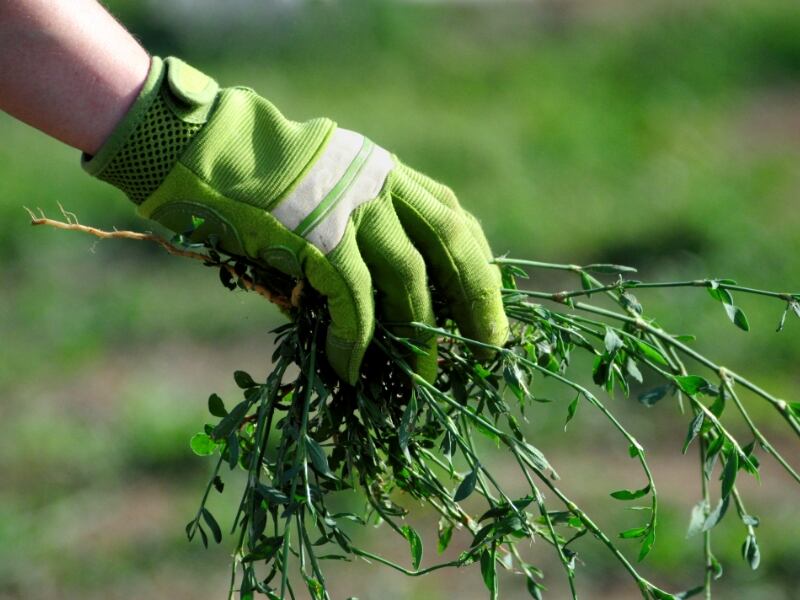
Just like you appreciate the spring sun, so do the tiny weed seedlings that lie dormant in your lawn. They’re ready to swoop in and outgrow your slower, yet much more desirable, grass varieties. Right before these weeds begin to sprout, typically when soil temperatures consistently reach about 50 to 55 degrees Fahrenheit, apply a pre-emergent herbicide.
Avoid weed and feed combo products that promise fertilizing and weed control benefits in one package but usually fall short on both counts.
Note: If you overseeded your lawn in early spring, wait until you’ve mowed the new grass at least three to four times before applying any pre-emergent herbicide. This will ensure the new grass is mature enough to withstand the herbicide application.
Fertilizing — Late April – Early May
Late April is often ideal for the first round of fertilizing your lawn. So, how do you fertilize your lawn? You should apply a light, slow-release fertilizer at around half a pound per 1,000 square feet. This “less is more” approach helps encourage healthy root growth without triggering excessive top growth, which can stress the grass and make it vulnerable to pests and diseases.
If you’re unsure of the fertilizer your lawn needs, take a soil test. This will tell you precisely what nutrients your lawn requires.
Note: After you’ve applied the fertilizer, wait at least 24 hours before mowing. The stress of cutting and fertilizing on the same day can end up damaging your grass.
Keep Up the Routine — May
As we step into May, let’s maintain a regular routine of mowing our lawns to keep them within the 1.5 to 2.5-inch sweet spot. Mow approximately once a week and remember the one-third rule to ensure healthy growth.
You’ll also want to water your lawn deeply and infrequently — aim for an inch per week, including any rainfall. Avoid shallow watering, as this encourages roots to stay towards the surface rather than growing deeper into the soil, making them less hardy in summer when faced with drought conditions.
Have you noticed any broadleaf weeds popping up like dandelions? If so, pull them out by hand or use selective herbicides to get rid of stubborn weeds in your grass if absolutely necessary.
Summer Lawn Care in Maine: June to August
As we roll into the months where the sun is high and sipping lemonade in your garden can become a daily ritual, let’s not forget about our lawns.
Adjust Mowing and Watering for Summer Heat — All Summer
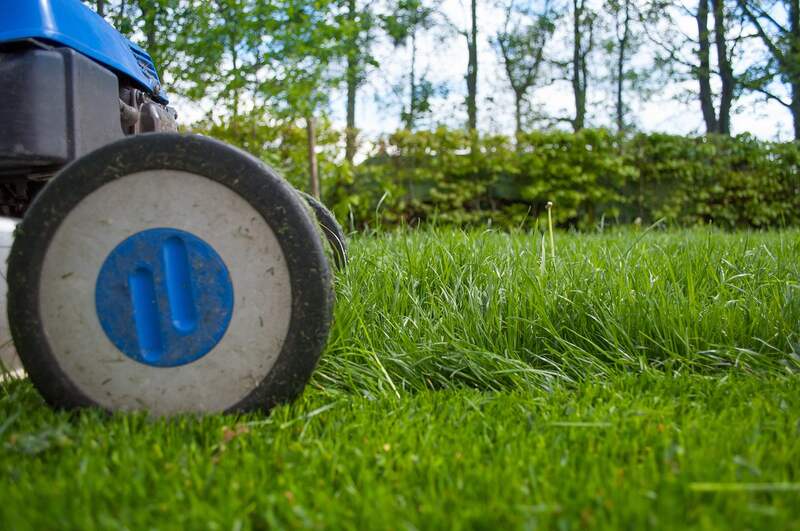
Maine’s summer temperatures can often hit above 90 degrees Fahrenheit, so it’s important to raise your mower blade during this period. Adjusting your mowing height to 3 to 4 inches actually helps shade the soil, which reduces evaporation and keeps those critical root systems cooler.
The watering needs also need to change for this season. Aim for around 1.5 inches per week, rainfall included.
Monitor for Pests and Diseases — June
June is possibly one of the best months to get the most out of your lawn, with the weather being just right and your grass looking its best. However, it’s also time to keep an eye out for any unusual signs of pests and diseases that might lurk in your yard. Early detection will always make treatment far easier.
In Maine, common lawn invaders include grubs, chinch bugs, and sod webworms. If you spot irregular patches on your lawn or evidence of insect activity, identify and treat them accordingly before they have a chance to spread.
Treat Heat Stress — July
As midsummer approaches, signs of heat stress may start appearing on your lawn. A prolonged heat wave or drought-like conditions can cause your lawn to go dormant and turn brown. This is just a natural defense system and won’t harm the grass long term.
You can help it recover faster by adjusting your watering schedule and ensuring that you water in the early mornings, between 5 a.m. and 9 a.m., to minimize evaporation loss.
Be prepared for potential disease outbreaks like brown patch or fairy ring, which love the hot, humid weather as much as we do. Regularly inspect your lawn for these and other diseases, and treat them as necessary to prevent the disease from spreading.
Aerate and Dethatch as Needed — Late August to Early September
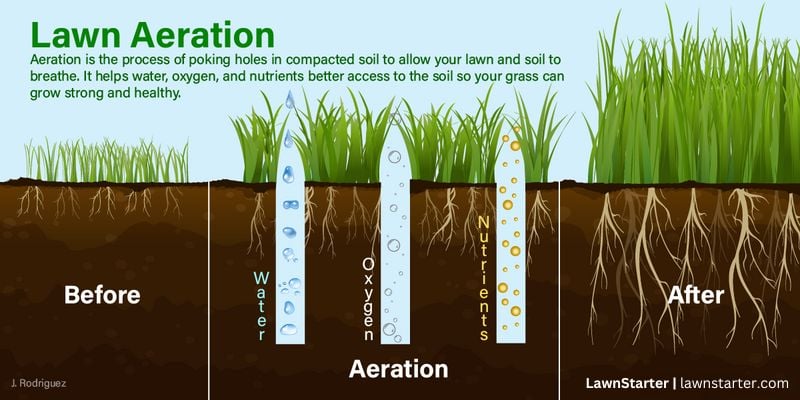
As late summer rolls into Maine, consider aerating your lawn. Over time, the soil in your yard can become compacted, which makes it hard for grass roots to penetrate deeply and access water or nutrients.
Your thatch may also have built up above 1/2 inch by now. The thatch in your lawn is nothing but a mix of dead and living organic matter, like grass clippings, leaves, and twigs, that live on top of the soil surface but under the green shoots. While a bit of thatch helps keep moisture in during hot summers, when it gets too thick, it hampers air and water movement from reaching the root zone easily. For more details, check out Signs Your Lawn Has Excessive Thatch.
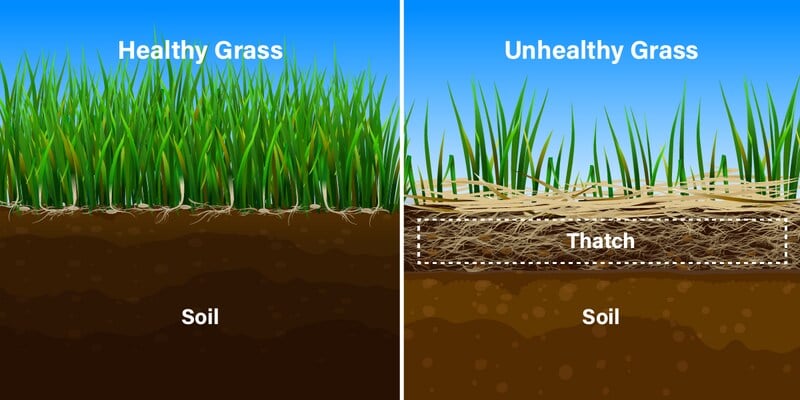
If you spot this occurring in your yard over the summer, you might want to comb through your calendar to set aside some time in late August or early September for a proper dethatching and aeration treatment.
Overseed to Thicken Lawn — Late August to Early September
Often overlooked until fall comes along, but equally important, is overseeding. If you’ve tackled patchy, thin, or bare spots in the spring, they should be filled in by now with lush growth. However, if you overlooked this step or if new thin or bald patches have sprung up during summer, late August to early fall is a good time to take care of these.
Select seed types that complement your existing species, like Kentucky bluegrass, perennial ryegrass, and fine fescues. Remember to keep these patches moist, at least till the fresh grass has had a chance to establish itself.
Fall Lawn Care in Maine: September to November
Autumn months can be some of the most beautiful yet challenging times for your lawn. Failing leaves are your main adversary during this season. They can strangle your lawn by blocking essential sunlight. But what else needs your attention?
Fertilizing — Early September
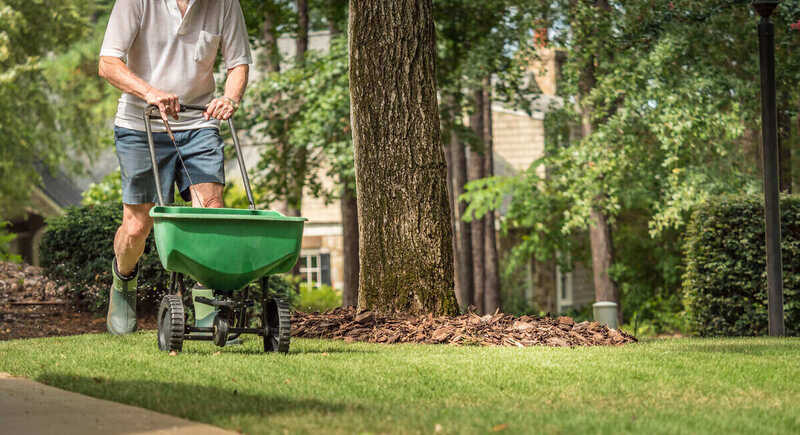
With the scorching summer sun behind us and cooler days ahead of us again, it’s time to give those roots one more punch of slow-release nutrients. Around Labor Day (early September), apply around 0.5 to 1 lb of nitrogen per 1,000 square feet on your lawn.
This will help promote root development because even though top growth slows down as we head into autumn, the grassroots will continue their growth.
Rake and Clear Leaves — Throughout Fall
As the trees begin to shed their foliage, it is time to keep your lawn clear of heavy leaf litter. Regularly rake and remove these leaves. Leaving them can suffocate your grass by blocking sunlight and trapping moisture, which can lead to diseases.
If you have a light layer of leaves across your lawn, improving your lawn with mulch can be a simpler solution. This sends the organic matter back into the soil as these mulched leaves decompose over the winter. Just ensure that leaf piles aren’t accumulating at any one spot.
Continue Mowing — September to October
Keep mowing regularly, but raise the cutting height as grass growth slows heading into the fall, typically by early to mid-October. Aim to mow once per week in September and every 10 to 14 days in October, depending on growth.
Some species of cool-season grasses common for Maine lawns, like Kentucky bluegrass, perennial ryegrass, and fescues, will require a slightly higher mowing height of 2.5 to 3 inches during this season. This not only promotes deeper roots but also enables your lawn to store more nutrients for winter survival.
Prep For Final Mow — Mid to Late October
As we head towards late October, when winter is almost at our doorstep, it’s time for that final cut before hibernation starts setting in.
By reducing your cutting height down somewhat for this last mow (although never going below 2 inches), you are effectively reducing the odds of snow mold, a common winter lawn disease here in Maine.
Clean and Winterize Your Mower — After Last Cut

Winter in Maine isn’t just tough on you or your lawn; let’s also spare a thought for our mechanical friend: the lawn mower. It has had quite an active season tackling tall grass, leaf mulching, and maybe even an occasional twig or two.
Given its contribution, it’s only fair that we take some time to properly clean and winterize it after that final mow before retiring it till the next spring pops up. Here are some things to include in your lawn mower winterization checklist:
- Clean the lawn mower underside thoroughly to remove any grass clippings or other debris.
- Remove the mower blade, clean it, and give it a good sharpening.
- Run your mower until the fuel is consumed, or add a fuel stabilizer to any remaining gas.
- Replace or clean air filters, and change the oil if it is visibly dirty.
- Store your mower in a dry, protected place to prevent rust and damage from freezing.
Final Watering & Winterize Irrigation System — Late October to Early November
Before winter truly sets in and the night temperatures dip towards freezing, water your lawn deeply one final time if rainfall hasn’t been sufficient. The moisture will get stored in those deep grassroots all through winter, keeping them hydrated until spring arrives again.
Make sure also to winterize your irrigation system. Shut off any outdoor water supply valves and drain all water from the hoses to avoid any freezing pipes.
Perform Final Fall Cleanup — November
As the season winds down with the trees bare and no green leaves in sight, thoroughly clean up your yard one last time before snow falls.
Rake away leaves out of those hidden corners or under shrubs where lawn mowers couldn’t reach months earlier.
Also, store away any remaining garden tools after cleaning them so they’re ready for action come next spring. This includes oiling moving parts or sharpening lawn mower blades where necessary.
Winter Lawn Care in Maine: December to February
During Maine’s brutal winters filled with snow, frost, and freezing temperatures, one might think there isn’t much to do when it comes to lawn care. But even during these frosty months, there are precautions to take that will help ensure the survival of your turf.
Avoid Foot Traffic — All Winter
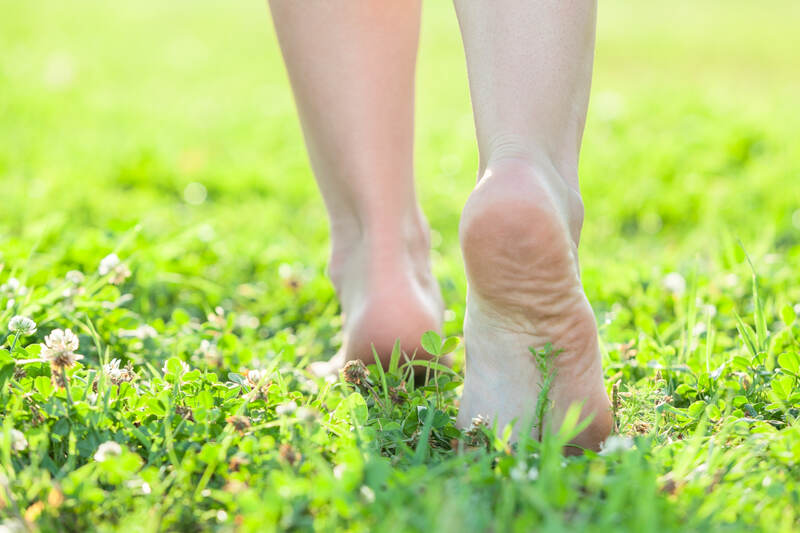
Resist walking on frozen lawns as much as possible because you can cause significant damage without even realizing what’s happening underneath. Even a casual stroll can break the leaf tissue and damage the crowns of the individual grass plants, leaving them weakened or even killed off when spring comes again.
Avoid Using Rock Salt Near Lawns — All Winter
In Maine’s frigid winters, rock salt becomes a common sight for de-icing walkways and driveways. Unfortunately, these rock salts can potentially harm your lawn when they dissolve in melting snow or ice and are absorbed into the soil, causing root damage and inhibiting nutrient absorption by the grass.
Monitor Your Lawn for Snow Mold — Late Winter
Snow mold is a pesky fungus that tends to show up in late winter and early spring after the snow begins to melt. Keep an eye out for grayish-white circular patches on your lawn, which could indicate snow mold.
If you spot signs of this disease, lightly rake the affected areas to uplift the matted grass and improve airflow, which will help the grass dry out faster.
Start Planning For Spring — From February
While birdwatchers start looking out for first robins around this time, have your calendar handy and begin scheduling your spring lawn care tasks.
It’s also a good idea to get the soil tested now if you haven’t done so in the last 3 to 5 years or are seeing a lot of moss growth or yellowing despite adequate fertilization.
FAQ About Maine Lawn Care
What is the Easiest Grass to Grow in Maine?
The easiest grass to grow in Maine is probably Kentucky bluegrass. Known for its hardiness and ability to withstand the state’s often harsh winters, this perennial grass type thrives in full sunlight and well-drained soils. It also has a strong tolerance against common lawn diseases that are prevalent in Maine.
For more options, check out our guide on the best grasses for Maine.
How Do You Treat Grubs in Maine?
Grubs can be treated with a targeted insecticide. This should ideally be applied in late summer, when grubs are young and actively feeding near the surface of the soil. Opt for a product specifically labeled for grub control and follow the instructions while applying it.
Alongside the treatment, ensure your lawn is well watered, mowed correctly, and adequately fertilized. Healthy lawns tend to be less attractive to beetles.
What Type of Maintenance Does my Lawn Need After Heavy Rainfall?
After heavy rainfall, your lawn will need some special attention. Here’s a quick checklist:
- Avoid walking on your wet lawn, which can compact the soil and damage the grass.
- Allow the grass to dry before you mow. This makes it much easier to cut and less likely to spread disease.
- Check for any signs of waterlogging or pooling, particularly in low-lying areas of your yard.
- Check for any washout, especially around garden beds and sloped areas which might require reseeding.
A Season for Every Lawn Task
Now that we’ve walked you through a year’s worth of lawn care duties, from the first thawing days of spring through the wintry hush, your green thumb must be itching to get started. And why not? Your lawn is, after all, one of the first things people notice about your home.
But sometimes life’s errands get in the way of our best lawn care plans. Deadlines, appointments, or maybe you’re just taking some “me time” like Maine’s favorite son, Stephen King. “Get busy living or get busy dying,” he famously said, “so pull up your sleeves and rake some leaves.” Okay, maybe he didn’t actually say the last part, but when daily life supersedes lawn care duties, just remember you have another option.
LawnStarter helps you connect with local lawn care pros who understand the unique lawn care needs across various Maine regions. From Portland to Presque Isle, they’ll be there, mowing, trimming, and seeding their way through the seasons to ensure your lawn looks its best all year round.
Main Image Credit: Pexels created using Infogram